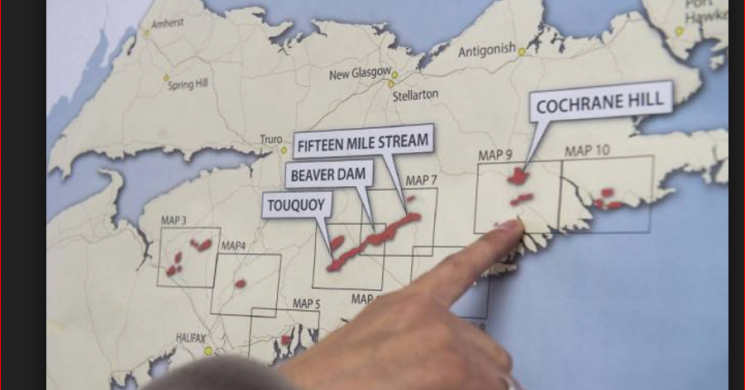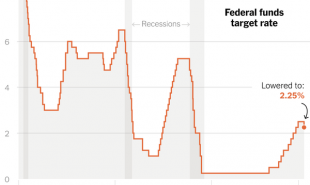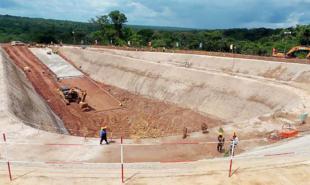
Atlantic Gold: The Next (overlooked) Gold Mine
via Nick Hodge
I was in Vancouver recently for a conference and got to sit down with Atlantic Gold (TSX-V: AGB)(OTC: SPVEF) Chairman and CEO Steven Dean. We had a nice, long chat about the junior gold market, and what majors are looking for as they continue to make acquisitions to replenish their reserves. The topics discussed throughout the interview are highly valuable for precious metals investors of all stripes. Members of my Wall Street's Underground Profits letter have been buying Atlantic Gold since last November. They are up 57%. Much more is ahead for Atlantic, as well as the nine other gold companies I recommend here. Enjoy the interview and look for Part II tomorrow.
Nick Hodge: Hi. This is Nick Hodge, Editor of Wall Street's Underground Profits. I'm here on the sidelines of the International Metals Writers Conference in the Coal Harbour room at the Pan Pacific in Vancouver. I'm sitting here with Steven Dean. He's the Chairman, CEO, and Director of Atlantic Gold (TSX-V: AGB)(OTC: SPVEF), which is the only fully financed, permitted and under construction gold project owned by a junior in Canada. We were just going to have a little chat here about the gold markets and what's been going on, particularly as it relates to the acquisition of junior gold companies in Canada.
Steven, what's the trend been? We've seen just in the past couple of weeks or so Eldorado take out Integra, and before that we've seen Kaminak taken out in the Yukon. Why is the trend towards buying out Canadian juniors? What's the rationale behind the majors there?
 Steven Dean: Well, as you know, Nick, I've been in this business for almost 30 years, and so part of it is just where we are in the cycle of the sector, but the other part of it is it's getting more and more difficult to find and own production in the safer places, jurisdiction-wise, around the world. As a result, there's been a fair amount of focus of activity on companies with projects in mining-friendly jurisdictions, mining tradition countries like Canada, and North America generally, but particularly Canada. A lot of companies want to rebalance their jurisdictional risk, the bigger ones at least, by bolting on local production in Canada. The Eldorados, the Goldcorp acquisitions in recent times, I think are partly driven by that.
Steven Dean: Well, as you know, Nick, I've been in this business for almost 30 years, and so part of it is just where we are in the cycle of the sector, but the other part of it is it's getting more and more difficult to find and own production in the safer places, jurisdiction-wise, around the world. As a result, there's been a fair amount of focus of activity on companies with projects in mining-friendly jurisdictions, mining tradition countries like Canada, and North America generally, but particularly Canada. A lot of companies want to rebalance their jurisdictional risk, the bigger ones at least, by bolting on local production in Canada. The Eldorados, the Goldcorp acquisitions in recent times, I think are partly driven by that.
Nick Hodge: Going back to the Integra story, their primary operations were in Greece and in Turkey, in two places that in recent years that have had some geopolitical tensions, some debt crises. What makes Canada a mining-friendly jurisdiction? And particularly Nova Scotia, if you will.
Steven Dean: Sense of trust in the transparency in the rules. The ease with which the process can be followed to put a new mine into production. A lack of expropriation of assets in the history of the country. Those sorts of things would drive that. For us in Nova Scotia specifically, through two different sides of politics in provincial politics in Nova Scotia it's been a province that has been supportive of the mining sector. Industry in other sectors has been declining, like in the forestry business, in the fishery business in maritime Canada. What the mining business brings is jobs and employment and economic activity in the interior of the province, which most industries don't or can't. That's where jobs are in most need. As an industry, I think we bring good things to a provincial economy.
Nick Hodge: You're no stranger to putting together projects, specifically producing projects that majors have taken an interest in. You were a founding member of the Normandy Poseidon group that ultimately became the largest gold producer in Australia and was taken out by Newmont. You were also a co-founder of PacMim, which was ultimately absorbed by Teck. Can you talk a little bit about what you learned in those takeout and absorption processes and how you're translating that into Atlantic Gold's current project?
Steven Dean: No one company is ever the same. I think Normandy was 12 years in the making before it was acquired in that three-way merger with Newmont and Franco-Nevada. PacMin, for example, was of the order of three or four years. It depends on where we are in the cycle. But, inevitably, because of the fact that this is a depleting resource business, that the larger companies do need to aggregate and add to their resources. As a former president and/or CEO of senior or intermediate companies, you have to include acquisitions, M&A activity in your source of growth — in addition to things like exploration, of course — in order to continue to grow and even just replace those depleting resources.
Nick Hodge: I think you have a great project that could help potentially a major replace some of those depleting resources. You have the Moose River Consolidated Project in Nova Scotia. It's under construction. It's on budget. It's ahead of schedule. It's scheduled to be commissioned in September, to begin producing gold in September. Can you talk a little bit about what differentiates Atlantic Gold from other juniors out there and why, as a junior stock goes from development into production, there can potentially be a re-rating in the stock and why it becomes more valuable?
Steven Dean: I'm glad you raised the question of differentiators, because I think every company should have differentiators within their strategic thinking, because that will drive strategy going forward for each and every company, and that's an important part of how you grow a business. The differentiators that I think we have in particular are a high degree of insider and board ownership. Board and management own of the order of 35% of the company, together with associates.
As a management group, we've got a long and deep track record of growing companies from a small base to a larger one. You touched on a little bit of my background, but also Maryse Bélanger, COO, has got a very strong background in helping to grow the businesses of Kinross and Goldcorp in their early days. They're two key differentiators, and that second one is all about people. It doesn't matter what industry you're in, the track record of the people who you're trusting your money with as shareholders is absolutely critical in making an investment decision.
I think that the biggest differentiator for us amongst our peers is what we call risk management. To be clear, what risk management means in our sense is things like entering into fixed-price contracts for the construction and development of the mine. We have a contract with a company called Ausenco who I have known for a long time. They're originally Australian-based, but they've got a very large North American presence here now.
This will be the first gold processing facility constructed under a fixed-price contract. Why that is important is that it helps us as management defray those and manage and eliminate in some cases the risks attached to developing gold projects. The history of our sector, unfortunately, has been one where management have promised certain things on bills and capital budgets, and in many cases in recent times haven't delivered. As a result, it lost the confidence of investors. That's one.
Things like high-density production drilling, or we call it grade control drilling, which manages the risk of tonnes and grade. It helps us as management delineate with greater accuracy, because of the amount of data we have, ore and waste in the floor of an open pit. We did that almost two years ago, and that resulted in us as management, but also our financial supporters, including our bankers, as a result had a much higher degree of confidence in the resource and the deliverability of the tons and grade that we expected, particularly in that first year of startup.
Nick Hodge: Let's talk about the project specifics a little bit. It's great to see, and refreshing I'll add, to see a junior be good stewards of shareholder capital and under-promise and over-deliver, as opposed to the inverse of that. Now, the people is one thing, and it's great to see the people and the track record and how they manage risk, but that also translates to the project as well, because it's a fantastic project. Do you want to talk about the capital cost of the project, the all-in sustaining costs, and maybe a little bit about why being in Canada and the currency valuation at the present day helps Atlantic Gold?
Steven Dean: Sure. We were very deliberate about our strategy in identifying Moose River as a project for us to take forward. Nick, you mentioned capex. That was a big driver for us in terms of the attraction of the project for us to develop. It's what we call a manageable amount. It was of the order of $130, $140 million of Canadian dollar capital. That differentiates it in itself, because that's something, even in a tougher capital markets environment that we've experienced up until a year or two ago, it was something that we could finance with the combination of bank debt and our own capital, which is what we ended up doing. That was a big plus.
The location is a big plus. The fact that we're about 45 minutes' drive, literally, from Halifax International Airport means that infrastructure is very present. We didn't have to run power lines very far. We didn't have to construct highways to the door. All of those things were already present. Our workforce is essentially on our doorstep in the surrounding areas of Dartmouth and Halifax, which means we don't have a typical camp. We don't have to construct an ice runway, as we do in some parts of Northern Canada, for flying in and flying out of supplies and fuel.
All those things add up incrementally to lowering, or in some cases, if you don't have those things present, increasing incrementally those cash costs, and capital costs for that matter. Canadian dollar, you mentioned that. That's an important driver. You're effectively building a project with a 25% discount to the U.S. dollar right now, and that's a big plus. Those are the sorts of things that attracted us to our project of Moose River. From a geological perspective, that was a big attraction to us as well.
Nick Hodge: You mentioned a lot of things there that majors have publicly stated they're looking for in potential acquisitions and buyout targets: the jurisdictions, the access to workforce, the mining-friendly nature of Canada and Nova Scotia. The project itself already checks a lot of boxes. But there's more potential there. You guys already have a 2.1 million ounce global resource, and you're working towards, as I understand it, a new resource estimate. And there's potential for more discoveries.
I think in the latest slide deck, if I'm not mistaken, I noticed one of the slides said you think there's potential for another deposit discovery at the Moose River project. Can you talk a little bit about, in addition to being headed to production in September, the upside, the exploration potential at Moose River?
Steven Dean: The project as we know it, as we call it, Moose River Consolidated, is really a consolidation of four different deposits that are all within trucking distance of the central milling facility that we're presently constructing at the moment at Moose River. The approach we're taking on the exploration front is twofold. One, there are two deposits, which we call Cochrane Hill and Fifteen Mile Stream, which were not in the base case feasibility study, but they were indicated in inferred resource categories, which means that what we needed to do was do some more drilling to increase the density of that data, which will allow us to then categorize those resources as measured. As soon as we've done that, that then allows us to incorporate those deposits — that's just over 1.1 million ounces, actually — as an additional production source for our base case project. That was part of it.
The other part is what you're referencing there, the pure exploration side. Believe it or not, this is the first time there's ever been any modern exploration for the deposit model that we have. That deposit model is an open-pittable resource, in other words within 200 or 300 meters of the surface, where you've got a package of mineralized rocks, starting with the traditional quartz veins that were mined since the 1830s by the old-timers, that sit in the host argillite rocks, the shales, that happen to also be mineralized. Those host rocks, the argillite rocks, are not mineralized at grades that are as high as the ones we see typically in the quartz veins, but they are very profitable and very economic at grades between one-and-a-half and two grams in an open pit.
What our exploration model is, is: Where do these two domains of mineralization coincide? The quartz veins sitting in these argillite rocks. The argillite rocks were never of interest to the old-timers because they were below economic cutoff, they were low grade. But when you combine them and put them in an open pit, the economics of those are very strong. As you well know, with our Touquoy deposit it's a two-to-one strip ratio, around $520 U.S. dollar-equivalent cash costs, all-in including sustaining costs.
It's the combination of that grade, the infrastructure in the area, the Canadian dollar, and the low strip that drive those costs. We're convinced that there are other deposits like these yet to be discovered.
Read more by Soren K.Group







